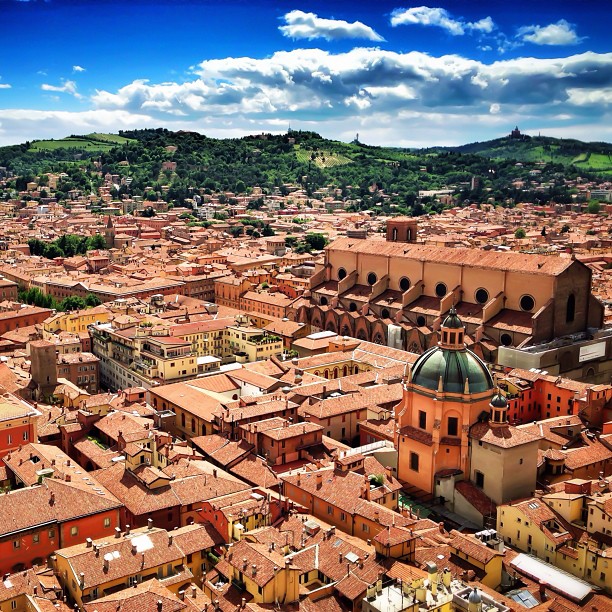 Situated between Lombardy and Tuscany and stretching from the Adriatic Sea to almost the Mediterranean coast, Emilia-Romagna is a key region in northern Italy. These are, in truth, two provinces: Emilia and Romania, former papal states reunited after the unification of Italy. Before the papacy took over the region, it was the patching of princely territories owned by several families - d'Este in Ferrara and Modena, Farnese in Piacenza and Parma, and lesser dynasties in Ravenna and Rimini - which created flourishing Renaissance mansions, linking autocracy with the patronage of the arts and constantly struggling with the Church for power. Their castles and fortresses remained, preserved in cities with restored medieval centers, lying - apart from a few notable exceptions - rather away from the usual tourist routes; travelers are deterred from the region by climate extremes (unbearable heat in summer, almost frost in winter), and at the same time they attract nearby Tuscany and Umbria.
Situated between Lombardy and Tuscany and stretching from the Adriatic Sea to almost the Mediterranean coast, Emilia-Romagna is a key region in northern Italy. These are, in truth, two provinces: Emilia and Romania, former papal states reunited after the unification of Italy. Before the papacy took over the region, it was the patching of princely territories owned by several families - d'Este in Ferrara and Modena, Farnese in Piacenza and Parma, and lesser dynasties in Ravenna and Rimini - which created flourishing Renaissance mansions, linking autocracy with the patronage of the arts and constantly struggling with the Church for power. Their castles and fortresses remained, preserved in cities with restored medieval centers, lying - apart from a few notable exceptions - rather away from the usual tourist routes; travelers are deterred from the region by climate extremes (unbearable heat in summer, almost frost in winter), and at the same time they attract nearby Tuscany and Umbria.
The landscape of the region is varied - from the foothills of the Apennines to the flat ones, the sun-baked fields of the northern Po plain (Po Valley), sheltered from the wind only by poplar clumps. Grain has been cultivated here since the Roman times and today the local agriculture and related industry are the most developed in all of Italy - there are more pigs than people in the Po Valley, and in Emilia there are some of the most flourishing enterprises, which contributed to the rapid development of the country in the 1980s.
Via Emilia is the central and natural reference line, crossing Emilia and Romagna straight from Piacenza to Rimini. This Roman military road was built in 187 r. p.n.e.; it was then part of a medieval pilgrimage route to Rome, also leading the crusaders to the east, to Ravenna and Venice. Cities, which grew up around her, are among the most beautiful in Emilia. The capital of the region, Bologna, is one of the largest cities in Italy. And yet, despite the fact that here is one of the most beautifully preserved historic centers in the country and that Bologna is famous for its excellent cuisine and people with an open and peaceful character, which contrasts with the neurotic Milanese - it is quite neglected by tourists; most people glance at the city only briefly, which is undoubtedly a mistake. From Bologna, Modena and Parma are also within easy reach, where the journey by train takes about an hour. These wealthy provincial towns form the self-righteous core of Emilia and contain some of the most beautiful and atmospheric architectural monuments in the region: they are also a base for trips to the Apennines. By car, you can quickly get to the foot of the mountains from any of these three cities, tasting local cuisine and watching local festivals along the way; even traveling by bus, you can enjoy the beauty of this region, which is nothing like the lowlands to the north, where life is much more pragmatic. For mountain hikers, we recommend the Grand Escursione Apenninica, 25-day trip from shelter to shelter.
The north of Emilia-Romagna is less interesting than the section along Via Emilia; Here the Po flows into the Adriatic by a gloomy delta (which he shares with Veneto) and this inhospitable area of marshes and lagoons only attracts bird watchers. The coast to the south, on the other hand, is an excessively urbanized and polluted strip of land, Rimini at the southern tip may be of interest, though, in which, behind the modern glitz of the bathing beach, there is a surprisingly historic old town. Ravenna is located just south of the delta, having in its churches and mausoleums; probably the most beautiful collection of Byzantine mosaics in the world, in turn, Ferrara, a little further inland was the seat of the Este family, is one of the most important centers of the Renaissance in Italy.
You need to know, that the stay in Emilia costs a lot: it is a rich region, which does not suit tourists. Cheaper hotels can be dirty and depressing, and the more comfortable ones are more oriented towards businessmen. The atmosphere is probably like in Lombardy: good manners, elegant outfits and self-confidence. You shouldn't save on food, because the local cuisine is one of the best in the country. Emilia-Romagna is the birthplace of such typical Italian dishes, like spaghetti, prosciutto, salami and Parmesan cheese. This is where lambrusco comes from.